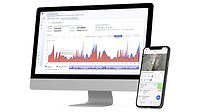Advances in deep learning & predictive analytics will significantly increase video intelligence capabilities in 2021

As we move past an unprecedented year of change, everyone is eager to see what 2021 has in store. For those in the security and surveillance space, of particular interest is how video content analytics might evolve to support emerging use cases. In that vein, Deep Learning and Predictive Analytics are among the key technologies that will continue to benefit video surveillance solutions development and adoption in 2021.
Here’s what we see on the horizon for these two important technologies as they advance video content analytics capabilities:
Going Deeper on Deep Learning
Video analytics software still varies significantly when it comes to price and accuracy of solutions, diversity of metadata (i.e., how many classes, attributes, etc.) and granularity (for example, car type versus car make and model). Competition among video analytics providers coupled with evolving end user requirements will continue to drive richer classification, more granularity, and reduced operation costs. And with more granular metadata, more applications can emerge.
Deep Learning is a powerful Artificial Intelligence tool which is rapidly driving advancements in many areas, including medical imaging, robotics, computer graphics and Big Data. Increasing hardware processing power along with more tagged data sets that can feed learning algorithms, are the main drivers of Deep Learning progress. For video analytics specifically, Deep Learning is the catalyst for improved accuracy and expanded video scene understanding. For this reason, the more case-specific video data is available, the more competent the analytics for that end user audience; however, surveillance scenarios available for training Deep Neural Networks are still somewhat limited, despite the increase in surveillance videos generated worldwide. We expect the surveillance industry to make efforts to bridge this gap as it influences the number and type of use cases available for surveillance offerings.
Next year we expect the following applications of Deep Learning for video content analytics to take center stage:
1. Anomaly detection
This capability will become more prevalent and comprehensive. Moving from identifying simple anomalies such as “an object appears where no similar objects appeared before,” to more intricate behavior detection. Anomaly detection will become a common tool for augmenting humans managing huge amounts of video: As always, Deep Learning is a tool for assisting a human operator – a human is an essential part of video analysis and anomaly detection and is required to evaluate the detected “anomalous” behaviors and events and validate if they are, in fact, “interesting.”
2. Scene understanding
Related to anomaly detection, this developing area of video content analytics enables operators to discern between behaviors that may seem identical when the only consideration is the movement of the immediate objects. For example, it can be used when evaluating whether a bag on the floor is attended or not or whether a running person is indicative of a larger ongoing event.
3. Persistent surveillance
The use of persistent surveillance powered by Deep Learning will become available, at small scales – and will be much less menacing than the persistent surveillance possible with our ubiquitous smart devices – in the forms of cross-camera tracking and unified metadata across a site. For example, a museum could use persistent surveillance to capture specific dwell areas and durations of people walking through an exhibit or even the entire museum. In retail, this application can demonstrate how customers engage with the displays throughout a store (across several camera views). This use case will unlock more value from existing and future video analytics infrastructure and may increase adoption.
Moving Toward Predictive Analytics
Along with innovation in Deep Learning will come the advancement of predictive analytics. Predictive analytics allow for better, more intricate information to be extracted from video. Enabling more complex multiple-input analysis of video content helps to identify underlying trends and assume valuable predictions. In the coming year, we anticipate the development of more prediction-based capabilities that are derived directly from the video or from the rich video metadata generated – allowing users to be more proactive and less reactive.
While humans are limited in the amount of data they can take in and analyze, AI can help achieve certain analytic activities. By combining video surveillance metadata with other data sources and sensors unparalleled business intelligence can swiftly be generated out of Big Data. As more data is aggregated over time and across multiple cameras, this increase in data will drive significant advancement in the ability to derive predictive analytics. These developments will make it easier for video analytics systems to detect more granular actions and interactions, such as the onset of crowding or violent activity, so that users can create automated alerts when norms and benchmarks are violated. Irregular behavior either can be reviewed interactively on-demand for deep insights or in real-time to drive proactive and immediate response based on alerts to evolving situations.
As we look ahead, predictive analytics will increasingly gain traction for use cases such as traffic flow optimization and predicting congestion. As metadata becomes increasingly more granular, predictive analytics will be able to assess and make more complex forecasts, such as those involving two or more related objects or humans. This will be particularly useful in scenarios where security professionals are looking to detect aggressive or malicious behavior before any actual harm occurs. Traditionally this has been a challenge because detecting these behaviors requires context in order to rule out false alarms. But granular metadata can help provide that necessary context so that humans can make accurate assessments when potential threats are recognized and trigger alerts.
With all the challenges of 2020 hopefully behind us, the year ahead will be a springboard for all the technologies that provide the most value to the widest variety of professionals – taking video surveillance technology out of security siloes and evolving it to solve the challenges of stakeholders across an organization. Deep Learning and Predictive Analytics are two key technology directions for charting the road ahead in both surveillance and business evolution.
Looking for a reprint of this article?
From high-res PDFs to custom plaques, order your copy today!





